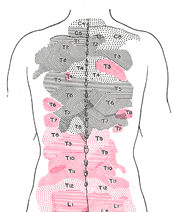Cluneal Nerve Blocks & RFTC
 A cluneal nerve block is a specialized treatment method for chronic lower lumbar back pain. Pain in this region of the back often spreads to the upper buttocks. Furthermore, lower back problems are among the main health issues that afflict people in the United States. Moreover, back problems are the leading cause for missed time from work.
A cluneal nerve block is a specialized treatment method for chronic lower lumbar back pain. Pain in this region of the back often spreads to the upper buttocks. Furthermore, lower back problems are among the main health issues that afflict people in the United States. Moreover, back problems are the leading cause for missed time from work.
Note: For your safety, the procedure cannot be performed if you have an active infection, flu, cold, fever, very high blood pressure or if you are on blood thinners. Please make your doctor aware of any of these conditions.
How Is A Cluneal Nerve Block Performed?
Preparation for the cluneal nerve block procedure involves having a patient lie facedown on a table that is equipped with X-ray machinery. The skin is then sterilized and, if an intravenous anesthetic is necessary (an IV), it is set up along with a monitor that records vital signs (e.g., heart rate, blood pressure, and breathing). Topical anesthesia is applied to the lumbar region before the procedure begins if the patient does not need intravenous anesthesia.
The clinician uses the X-ray to guide the injection needle into the lower back. The X-ray is called a fluoroscope and it provides an image of what is occurring in real-time. Once the needle has been correctly positioned, a dye is administered so that the region it circulates to can be observed. This step ensures that the steroid and anesthetic that are to be injected will be delivered as closely as possible to the affected cluneal nerves. The cluneal nerve roots are the target of the block procedure. The steroid targets the inflamed nerves and the anesthetic relieves the persistent pain.
Cluneal-Nerve-1A recently reported study described the effect of nerve block procedures that were performed to treat painful cluneal nerve entrapment. The nerve blocks were administered to 25 individuals who presented medial and superior cluneal nerve entrapment symptoms. All of the patients were treated with a single nerve block consisting of a steroid and an anesthetic. At a one-year check-up examination, each patient was asked about their level of pain and they all stated that they experienced pain relief.
As with other forms of treatment, this type of nerve block may result in certain complications although the occurrence is rare. Possible complications that may occur include tingling and numbness in the extremities, bleeding, an infection, and the possible puncturing of a nerve during the needle insertion.

